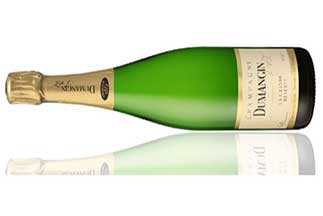Producer: Champagne Dumangin
Wine: Brut 1er Cru Grande Reserve Non Vintage - 375ml
Terroir: Champagne 1er Cru - Montagne de Reims: Chigny Les Roses, Ludes, Rilly, Taissy, Cormontreuil. 70% Clay, 30% Chalk
Varietal: 50% Pinot Meunier, 25% Chardonnay, 25% Pinot Noir. 45 to 80% reserve wine
Vinification: 95% Stainless steel & 5% barrels
Malolactic: Partial
Corks: Champagne bottle with DIAM cork (0% TCA = no cork taste)
Nose: Elegant, floral, and lemony, with notes of brioche, baked apples, farm fruits, and a crisp backbone.
Palate: Creamy, baked apples, honey and lemon
Food: Drink with any non-spicy seafood dishes or as an apéritif. Excellent with a triple cream like Mt. Tam.
Cellaring: Drink now
CHAMPAGNE DUMANGIN
Chigny-les-Roses, Champagne

The Dumangin family can be traced back to working in the vineyards since the 1650's. Champagne Dumangin was created by Hippolyte Dumangin in the 1890s in the 1er Cru village of Chigny-les-Roses. Jacky Dumangin, three generations later, perfected the characteristically feminine Premier Cru champagne range. His son, Gilles Dumangin, 5th generation of successful winemakers, expanded the domaine by introducing several high-end cuvees that helped position his domaine.
The installations for pressing and making the wines have been awarded the quality label by the CIVC. His press of 2000Kg (4409 pounds) combines modernism and tradition and is one of only two made of this type in the world. It crushes the grapes ever so delicately, with less pressure and more respect for the grape, adhering to the family philosophy of never "stressing" the grapes at any point during the production process. Gilles Dumangin is one of the few producers in Champagne who utilizes enamel tanks in which the porosity maintains a signature yeast component cuvee after cuvee.
Champagne Dumangin J. Fils has more than 13 acres in the prestigious Montagne de Reims and is considered a classic recoltant-manipulant (grower producer) who carefully controls every aspect of production, from picking to bottling, to hand riddling.
Champagne 1er Cru Grande Reserve is a blend of 50% Pinot Meunier, 25% Chardonnay, 25% Pinot
Noir and reserve wines (60% reserve, 40% newly harvested). The grapes are harvested from
25-year-old vines and fermented in stainless steel and enamel
vats. After the addition of a liqueur de tirage, the wine then
rests on its lees for thirty months before disgorging, which
takes place approximately three months before the wine is
ready for shipping. At this stage, a final dosage (of sugar)
dictates the dryness of the Champagne and the 'house' style.
Remuage (the process of moving the sediment to the neck of
the bottle before disgorgement) takes place manually and on
wooden stands. Estate bottled.
The Champagne production zone (AOC vineyard area) is defined and delimited by a law passed in 1927, encompassing roughly 85,000 acres of vineyards. There are four main growing areas in the Champagne: the Montagne de Reims, the Côte des Blancs, the Valley de la Marne and the Côte des Bar. Together they encompass nearly 280,000 plots of vine. 17 villages have a traditional entitlement to Grand Cru ranking and 42 to Premier Cru ranking.
Champagne has a history of vine-growing that dates back to the dawn of Christianity, and its vineyard boundaries have been defined by France’s appellation system (Appellation d’Origine Contrôlée or AOC) since 1927.
With its northern location, rugged climate, distinctive soil type and hillside vineyards, the Champagne terroir is the only one of its kind – as original as the wine it produces. Champagne had two major distinguishing features: northerly latitude and a dual climate that is subject to oceanic and continental influences alike.
Montagne de Reims
Montagne de Reims is one of the five sub-regions of the Champagne wine region. It is located north of Vallée de la Marne, Côte de Sézanne and Côte des Blancs. The region is located around Reims Mountain, from Reims to Épernay, and contains nine Grands Crus villages.
Information by: Champagne.fr








